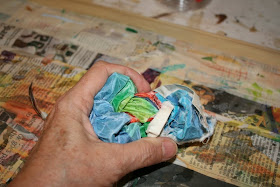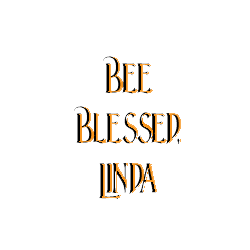I was fortunate enough to be invited to attend a "workday" with my sister and several of her artist friends. They are all current or former art teachers. What a great day we had! Most of us worked on a batik square. Mine is above. Not great, but I learned a lot and had fun doing it! The tutorial below is for a fairly simple method that you can do at home if you use liquid Rit dyes instead of the more expensive Procion dyes that my sister supplied. (Another artist was using Rit dyes and has had success with them.)
 | ||
| 2. If using professional ingredients, you need powdered dyes, sodium alginate (to thicken the dye) and soda ash to make it more permanent. |
 | |
| 3. Mix with hot water. You will want several disposable containers so that each has a different color. If using Rit dyes, just pour into containers. |
 |
| 7. When the wax is dry, remove the cloth from the board and wad up to crackle the wax. |
 | |
| 9. Place the fabric between several layers of newspaper and use an old iron to melt as much of the was out of the fabric as you can. As layers of newspaper soak up wax, remove and replace them. |
 |
| 10. This was my finished batik. |
For a "kid friendly" and kitchen friendly method of batik using washable school glue, see an older tutorial School Glue Resist .
If you use the Rit dyes with the School Glue Resist method, you will have a more permanent color.






You are so so talented, I am glad you all had a wonderful time, best part you/me learned something. I have one of your patterns, "Jesus Loves the Children".
ReplyDeleteIt was really fun! I am anxious to finish mine, too.
ReplyDeleteAdditional remarks that Judy told us was that when the soda ash is added to the dye it is only good for three hours or so. Judy mixes up a gallon of water mixed with soda ash and alginate to keep in her workshop refrigerator because it can be kept for long periods of time. She then takes out just a little chemical water at a time and adds the powdered dye to that using only as much as she needs for a project.
Also, adding beeswax and paraffin makes a safer wax mixture putting off less toxins and smoking less. The higher the ratio of beeswax to paraffin decreases the crinkling. I think maybe a 50/50 mixture may be a good starting point to play with.
Make sure the wax is good and melted before beginning to wax the fabric.
Great fun! My finger tips are only slightly dyed now and less obnoxious looking than a few hours ago.
Looks like you had a great time learning yet another way to use your artistic skills. Your work turned out beautifully! Thanks for sharing the method :)
ReplyDeleteI have been selling batiks in the quilt shop all summer and had no idea what was involved in the process. Is this the same process they use in Indonesia? Absolutely fascinating tutorial! Thank you very much for sharing on Toot-torial Tuesdays at RocknQuilts!!
ReplyDeleteWow is that gorgeous, one of these days I'm going to try this!
ReplyDeleteWhat a cute fish...looks alot like our (church's) school fish, Orville, who is summer vactioning in my kitchen!
ReplyDeleteOh wow - that sounds fantastic! And sooo much more complicated than it seemed when I did this at an Indonesian language holiday camp back in (upper) primary school!! We just did the white lines with dies, leaving out the additional black die at the end. I really didn't think much as to how much preparation has to go into getting it ready! Thanks Linda for such a great tutorial - I am definitely going to try this one of these days!!!
ReplyDeleteI love play dates like this - all the fun without having to buy loads of raw materials. A beginner would never have such a wide range of colours and equipment, but play datesnwith those who do is a real treat!
ReplyDeleteWhat great detail...afraid I'd make a big mess; but is very interesting...thank you for letting us see this process
ReplyDeletewhat fun...I have always wanted to try this!!!
ReplyDeleteTHanks!!
So beautiful! I remember doing this once..it was fun. YOur work is amazing. Happy creating. xo
ReplyDeletenonton siaran langsung ayam tarung bangkok
ReplyDelete